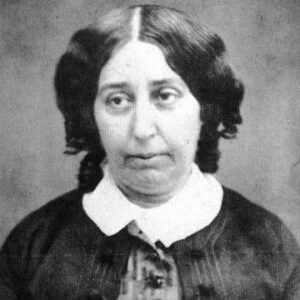George Sand was the pen name of French novelist Amantine Lucile Aurore Dupin. Following her young marriage to Baron Casimir Dudevant, she traveled alone to Paris in search of true love and economic independence. Her experiences in Paris with various men inspired several of her novels. Almost all of her novels are based on true stories about people she knew. She presented those tales with realism. In later years of her life, she used her novels, such as ‘Consuelo,’ to describe the deplorable conditions of working-class people. Her novels, such as “La Mare au diable” and “La Petite Fadette,” paint a vivid picture of rural life, and she wrote the majority of them while residing in Nohant. As a democrat, her literary works reflected her political views. Though her writings reflect her feminist attitude, she never advocated for women’s political equality. Rather than that, she defended women’s autonomy in selecting their lovers. Her later years were spent surrounded by her grandchildren, for whom she wrote “Tales of a Grandmother.”
Childhood & Adolescence
She was born in Paris, France, as Armandine Aurore Lucille Dupin, the daughter of Maurice Dupin, a soldier, and Sophie Delaborde. Her father was the grandson of Maurice, Comte de Saxe, the King of Poland’s illegitimate son. Her mother was a member of the common folk.
Armandine lost her father when she was four years old. Following that, she relocated with her mother and grandmother to Nohant, where her grandmother owned an estate.
In 1817, she entered the convent of the Dames Augustines Anglais in Paris. She later left the convent and returned to Nohant. At home, she spent her time studying various aspects of nature and treating peasants with herbal remedies.
Additionally, she studied the works of philosophers from various eras. She was influenced by the literary works of Francois Rene Chateaubriand, a French writer, during this time period.
Career of George Sand
Following her grandmother’s death, she inherited her grandmother’s estate in Nohant. In January 1831, she traveled to Paris in search of self-discovery and true love.
She used to earn her living by writing articles after relocating to Paris. She met a number of writers during that time period. She has affairs with a number of writers, including Jules Sandeau, Prosper Merimee, and Alfred de Musset.
She met Henri de Latouche there, who became her mentor. As director of ‘Le Figaro,’ he accepted several of her writings under the pseudonym Jules Sandeau.
Her novel “Rose et Blanche” was published in 1831. This was her first novel, co-written with Jules Sandeau.
In 1832, she published her first independent novel, ‘Indiana,’ which she wrote under the eponymous pseudonym George Sand. She continued to use this pen name for her subsequent novels as well.
Her earlier works, including ‘Lelia’ (1833), ‘Mauprat’ (1837), ‘Spiridion’ (1839), and ‘Les sept Cordes de la lyre’ (1840), were influenced by the various men with whom she worked.
After dabbling in social and class relationships through her writings, she discovered her true calling through her rustic novels, which were inspired by her childhood experiences in the countryside and reflected sympathy for the poor. ‘La Mare au Diable’ (1846), ‘Fran ois le Champi’ (1847–1848), ‘La Petite Fadette’ (1849), and ‘Les Beaux Messieurs Bois-Dore’ (1849) are among her rural-themed novels (1857).
Between 1854 and 1855, she worked on her autobiography, ‘Story of My Life’.
Significant Works of George Sand
In April 1832, she self-published her first novel, ‘Indiana,’ under the pseudonym George Sand. This novel provides an intriguing glimpse into the social lives of nineteenth-century women.
Her novel ‘Valentine’ tells the story of a love story between two people from disparate economic backgrounds. It tells the story of an aristocratic lady and her love for a peasant.
In 1833, she published ‘Jacques.’ The story of a retired soldier and his young bride is told in this novel. Sand addressed issues concerning a male character, the novel’s protagonist, for the first time in this novel.
Personal History and Legacies
In 1822, she married Baron Casimir Dudevant. Casimir was Baron Jean-Francois Dedevant’s illegitimate son. She had two children with Casimir, Maurice and Solange.
She had a brief romantic relationship with Aurelien de Se-ze. She traveled to Paris in search of love and independence, oblivious to her husband and children.
There she developed a friendship with writer Jules Sandeau. She ended this relationship when she became tired of Sandeau’s laziness and jealousy toward her.
She fell in love with poet Alfred de Musset after a brief courtship. She obtained legal custody of her child Solange following her divorce from Casimir in 1835. She developed romantic relationships with a number of men during this time period.
She had romantic relationships with composers Frederic Chopin of Poland, Prosper Merimee, Alfred de Musset, and Felicien Mallefille. Her close friendship with actress Marie Dorval contributed to the spread of lesbian rumours.
She spent the final days of her life at Nohant with friends and family. The natural splendor and serenity of this location assisted her in discovering peace in nature, children, and God. She died in 1997 at the age of 71.
Estimated Net Worth
George is one of the wealthiest Memoirists and is included on the list of the most popular Memoirists. George Sand’s net worth is estimated to be around $1.5 million, based on our analysis of Wikipedia, Forbes, and Business Insider.
Trivia
Prior to her marriage, this French novelist used to dress as a man and ride a horse with the encouragement of her eccentric tutor. She used to travel the countryside in men’s clothing at the time, unconcerned about social restrictions on women.


